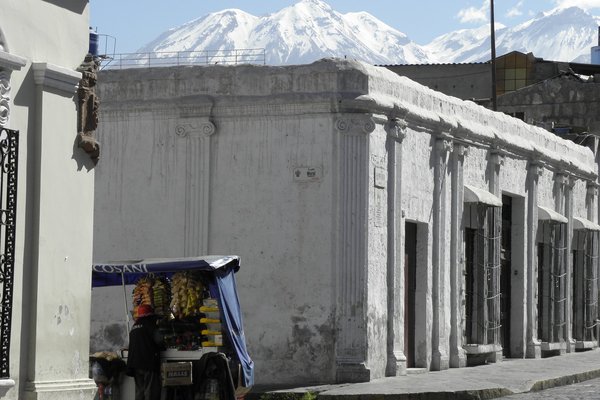Peru
Arequipa
The Historic Centre of the City of Arequipa is one of the most interesting examples of Latin American architecture and town planning.
Frequent earthquakes, the abundant presence of volcanic rock, known as silla, and the city’s geographical isolation lead to the development of a distinct local architecture. It is characterized by the robustness of its walls, extensive use of archways and vaults, courtyards and open spaces and baroque decoration of the facades. The artistic designs show the integration of European and native characteristics, resulting in some of the best mestizo Baroque buildings in the world.
Community Perspective: The convent of Santa Catalina and the ornate facade of La Compania are the highlights, but it is a pleasant city overall with a harmonious appearance.
Site Info
Official Information
- Full Name
- Historical Centre of the City of Arequipa (ID: 1016)
- Country
- Peru
- Status
-
Inscribed 2000
Site history
History of Arequipa
- 2000: Inscribed
- Inscribed
- Type
- Cultural
- Criteria
- i
- iv
Links
- UNESCO
- whc.unesco.org
- Official
-
- peru.info — Peru Travel
All Links
UNESCO.org
- whc.unesco.org — whc.unesco.org/
Official Website
- peru.info — Peru Travel
Community Information
- Community Category
- Urban landscape: Colonial
Travel Information
Recent Connections
-
Perfect Inscriptions
2000 -
Creative Cities
GastronomySee www.unesco.org
-
Mummies
Mummy Juanita, on display in Catholic U…
Connections of Arequipa
- Geography
-
-
Antipodes points
HISTORIC CENTRE OF CITY OF AREQUIPA=COMPLEX OF HUE MONUMENTS S16 24 0 W71 32 0 = N16 28 10 E107 34 40 -
Andes
(2380mtrs) - "The city of Arequipa, which is located in a valley between the slopes of the Andes and the desert of Ilay-La-Joya" (AB ev)
-
- Trivia
-
-
Dubbed 'White City'
La Ciudad Blanca (The building material is white "Sillar") -
Cultural sites closely connected to volcanoes
at the foot of three snow-covered volcanoes, ... With its buildings built mostly in white or pink volcanic rock (sillar) (OUV statement) -
Built or owned by Spanish
Arequipa was founded on 15 August 1540 by Garci Manuel de Carbajal (wiki)
-
- History
-
-
Fusion
"creative integration of European and native characteristics"
-
- Architecture
-
-
Vernacular architecture
dignified casonas, characteristic well-proportioned vernacular houses (AB ev) -
Designed by Gustave Eiffel
Mercado San Camilo - the roof was designed by Eiffel -
Neoclassical architecture
Arequipa Cathedral -
Baroque
-
Churrigueresque
Facade of the Jesuit church of La Compania, among others
-
- Damaged
-
-
Destroyed or damaged by Earthquake
Arequipa Cathedral, damaged by earthquake on June 23 2001
-
- World Heritage Process
-
-
Perfect Inscriptions
2000
-
- Religion and Belief
-
-
Franciscan Order
San Francisco church -
Mercedarians
La Merced Convent and Church "The Order of Mercy was expanding very rapidly and during the sixteenth century, it established convents in Trujillo (1535), Huamanga (1540), Arequipa (1540), ...."See orderofmercy.org
-
Cathedrals
Basilica Cathedral
-
- Human Activity
-
-
Cuzco School of Painting
Paintings in several churches -
Mummies
Mummy Juanita, on display in Catholic University of Santa María's Museum of Andean Sanctuaries (Museo Santuarios Andinos)See en.wikipedia.org
-
- WHS on Other Lists
-
-
U.S. Ambassadors Fund
Restoration of 17th- and 18th-Century Paintings from the Compania de Jesus Church in Arequipa (2010), Preservation of Cultural Patrimony in Arequipa (2008), Restoration of 16th-Century Oil Paintings in the Santa Catalina Monastery Museum (2005) -
World Monuments Watch (past)
Arequipa - Santa Catalina Monastery (2008) -
Creative Cities
GastronomySee www.unesco.org
-
- Timeline
-
-
Built in the 16th century
Several periods, but "the natural disaster of 1582 caused a major change in favour of antiseismic construction, introducing a systematic use of sillar" was the most influential moment
-
News
No news.
Recent Visitors
Visitors of Arequipa
- AC
- Adrian Turtschi
- Alberto Rodriguez Gutierrez
- Alejandro Lau
- alex
- Alexander Barabanov
- Alexander Lehmann
- Ali Zingstra
- Ammon Watkins
- Angela Vandyck
- Anna Wludarska
- Artsybrea
- Artur Anuszewski
- Atila Ege
- Bamse
- basementonline
- Bauchat
- BaziFettehenne
- Bill Maurmann
- Bin
- Bram de Bruin
- Carlo Sarion
- Carlos Sotelo
- CeeMon
- cflw
- Chantal den Haan
- Christravelblog
- Cirene Moraes
- Claire Bradshaw
- Clyde
- Col
- Colossus
- Cristina Erba
- CynthiaSam
- czesioszpachelka
- Daniela Hohmann
- Daniel Gabi
- Danieljbromberg
- dave wood
- David Marton
- del
- Delphine Delaunay
- Dennis Nicklaus
- Dirk-pieter
- DL
- Don Irwin
- DouglasR
- Els Slots
- Erfe91
- Erik Jelinek
- Eva Kisgyorgy
- Fan Yibo
- Feldhase
- Fernweh
- Filip Murlak
- Francky D'Hoop
- Frederik Dawson
- GabLabCebu
- Geert Luiken
- George Gdanski
- Gernot
- Gilles
- giloudepuertorico
- giulio25
- Hammeel
- Harald T.
- Harry Mitsidis
- H Beswick
- Hdhuntphotography
- headventure
- hotpickle
- Iain Jackson
- Ilya Burlak
- Ingrid
- Jacob Choi
- Jakob F.
- Jan Zimmermann
- Jarek Pokrzywnicki
- Jasonfd247
- Javier Coro
- Jens
- JL
- J_neveryes
- Joel on the Road
- jonathanfr
- Jon Eshuijs
- JoStof
- Joyce van Soest
- JR's HERITAGE SITES
- Karito Vies
- Kasper
- Kbecq
- KeithBailey
- Kevin McFarland
- Kjsisney
- Krijn
- Kurt Lauer
- leroykstlj
- Liamps91
- Linz
- Little Lauren Travels
- Loic Pedras
- Lucio
- Ludvan
- Luis Filipe Gaspar
- Lukasz Palczewski
- Maciej Gil
- Malgorzata Kopczynska
- manuel011197
- Mariam
- Marlies van Wolfswinkel
- Martin
- Mathijs
- Matthewsharris
- Michael Turtle
- Mihai Dascalu
- Mikko
- Milan Jirasek
- MMM
- Monica Tasciotti
- Morodhi
- nan
- natlefebvre@hotmail.
- Niall Sclater
- Nicole Lampos
- Nihal Ege
- PabloNorte
- Palimpsesto
- Patrik
- Paul Schofield
- Philipp Leu
- Philipp Peterer
- Pierre T
- Pink Bunny
- Piotr Wasil
- Ralf Regele
- Ralf Rotheimer
- Randi Thomsen
- Reza
- Riccardo Quaranta
- Rob Wilson
- Roman Bruehwiler
- RYU
- Sandmann15
- Sandra!
- sbshipway
- Sergio Arjona
- Shandos Cleaver
- sibariam
- Simonf
- Slavi
- Solivagant
- Sorel Americo
- Squiffy
- Ssong.x
- Stanislaw Warwas
- Stefan Loov
- Svein Elias
- Szabolcs Mosonyi
- Szucs Tamas
- Tatiana Nikulnikova
- Tevity
- Thomas Buechler
- Thomas van der Walt
- Tim Allen
- Timonator
- Tinuszke
- tony0001
- vhorne
- Viaje al Patrimonio
- Waxwing
- Wojciech Fedoruk
- zfish
- Zizmondka
- Zoë Sheng
Community Reviews
Show full reviews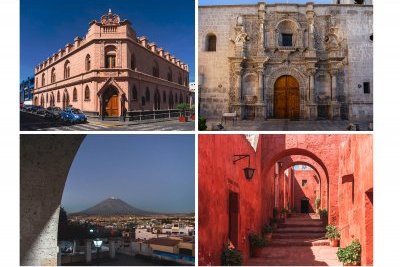
I visited Arequipa in May of 2024, possibly very close to the time that Dennis was there as well, and truth be told, I have little to add to his review. Arequipa is a type of town I usually label "not without interest" - a different way of saying "pleasant but not exceptional". The volcano peaks and the volcanic rock material used in construction add a bit of appeal. Mestizo Baroque church portals offer occasional eye-catching details, as do a number of buildings within the historic core grid. The overall ensemble, though, is no more than fine.
Santa Catalina Monastery is one unmissable attraction, a colorful city within the city. The painted Capilla de San Ignacio at La Compania is another highlight. Santa Teresa Monastery holds a reasonable collection of viceregal art, and the painted Chapter Hall justifies the few dollars of entry price all by itself. Other churches are more or less similar to each other in having outstanding portal decorations, fairly muted interiors, and rich altars.
The main square is an impressive public space, surrounded by portico-ed buildings on three sides and presided over by the cathedral on the fourth. I was not able to go inside the grand church – unlike elsewhere, it was off-limits for tourists sporting large cameras during masses and closed at other times while I was in town. I suspect it would be another highlight. Puente Grau, a historic bridge built from sillar, is among many points with great perspectives …
Keep reading 0 comments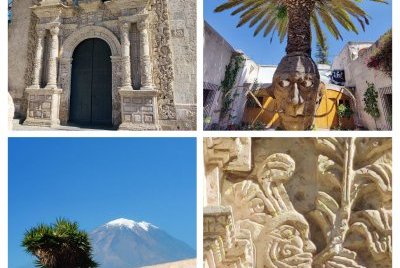
Arequipa is a pleasant enough city and I enjoyed my stay there, but it didn't seem particularly outstanding to me. The main square and cathedral are quite nice, and there are a couple nice small museums featuring Andean mummies. I think the volcano connection makes it a little special -- the city has grand views of multiple snow-capped volcanos, and the signature white buildings are made from pyroclastic stone. This is the first place where I was aware of that being used as a building material.
There are a variety of "free" walking tours around town. Most of the people I talked to didn't have great recommendations of the one they had taken, and I was disappointed in the one I joined also, but it did lead me to a couple interesting courtyards (upper right photo) and spots that I wouldn't have found on my own.
The description here mentions that local building "designs show the integration of European and native" and I noticed this in the unique carvings on the church at the Yanahuara scenic overlook (photos).
Arequipa is a good place to take a breather on a trip through Peru. I enjoyed nearby local attractions. I used Arequipa as the starting place for my Colca Canyon overnight trek, which was an intense day of hiking but very rewarding (and also not particularly close to Arequipa). Closer to town, I took the popular half day tour to the Ruta del Sillar, which takes you the quarry …
Keep reading 0 comments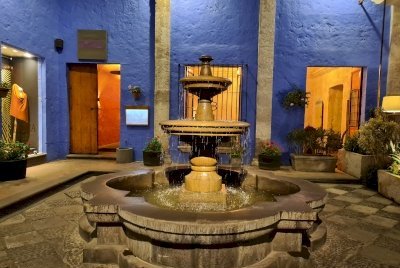
I had the pleasure to visit Arequipa around its anniversary on the 15th of August and that is of course reason enough to celebrate for a couple of days during the week especially in advance of the actual day of the anniversary. Nevertheless the places of interest were visitable although with reduced hours and on this way I could enjoy the combination of the colonial buildings in the famous "sillar" style (dried volcano ashes) and the colourful and loud celebrations of the recent population. For a good reason one of the main sights in the second biggest city of Peru is the monastery Santa Catalina. It offers the interesting combination of understanding the life of the nuns in the monastery from colonial times onwards until today and to enjoy the sillar architecture of Arequipa. It´s worth the 10€ entrance as you can spend half a day in the interior of the city inside a city. There are good explanations in English in the many rooms and places and there is also an App in English that describes 31 places inside the monastery. Alternatively you can take a guided tour that is offered in a few different languages as well. I liked the different colours of the different parts of the monastery that the walls were painted with. There is a blue patio, a red street and a white area. In the evening we could witness a parade in the street in front of Santa Catalina from a Crêperie. It was …
Keep reading 0 comments
I visited this WHS in June 2019. It was a last minute addition to my already packed itinerary but I'm glad I sacrificed a night in Lima for a night in Arequipa instead. Instead of using the night bus from Cusco, I opted for a comfortable early morning flight of only 1 hour. The airport is very close to city centre and the first thing you'll see in the desert landscape is the 5825m high active Misti volcano.
The main square Plaza de Armas was a bit disappointing as not much goes on there unlike other main squares in Peru. Perhaps being so big doesn't help in such a hot climate as most people who pass through the square, do so using the shaded arcades (Arequipa's marble UNESCO WHS inscription plaque can be found here). The Cathedral too seems to be too huge and out of proportion, in fact it is considered one of Peru's most unusual colonial cathedrals since the Spanish conquest. The highlight near the square is definitely the ornate facade of La Compania church which like most of the historic centre monuments and buildings is made of ashlar (sillar). This white volcanic stone is exceptionally soft, lightweight, weatherproof and emerged as a seismic structural solution in such an earthquake prone city. Several external buttresses can be seen all over the historic centre to help the structures from collapsing. In the Santa Catalina monastery you can still easily spot the damages caused earthquakes.
The second highlight …
Keep reading 0 comments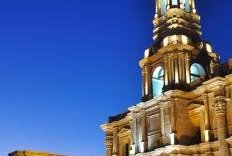
When my plane descended to Arequipa Airport, I wondered how on earth people settled in this hostile environment in the middle of very dry terrain next to volcano and questioned that Arequipa will be a good destination or not. However, when I approached the city area, I found that the city is quite green and prosperous than I expected. The taxi took me to the hotel in the center of historical area. Almost every building is built by white stone which was quite amazing to see how harmonious the color the city is. After check-in the hotel interior is brightly painted with red, yellow and blue and the courtyard is lushly bright green and full of blooming flower. I really impressed what I have seen and praised to hotel receptionist, but she said such interior can be found almost every building in the old city which later I discovered her words did not exaggerate at all.
Similar to other tourists, Santa Catalina Monastery was my first place to visit and indeed the monastery was really charming for its lovely gardens and breathtaking color walls with brightly red, yellow and blue similar to the hotel I stayed. The monastery is really interesting for its role for woman in old time, it was actually quite a privilege to be in the monastery and huge support money from family was a must. I was a bit surprised to discover that even in the past, money is needed to buy simple life! The …
Keep reading 0 comments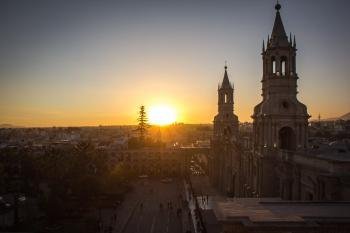
I didn't know much about Arequipa before going to Peru - even though it's the country's second largest city. In the end, it was a really pleasant surprise. I loved the feel of the place - the historic centre was very relaxed and had a welcoming atmosphere for visitors. The old buildings felt authentic and well integrated into their modern uses.
The scenery around Arequipa is stunning too and it's so nice to have the mountains on the horizon. Although obviously not related to the WHS listing, I would add that Arequipa is a great base to do some trips into the natural surroundings - Colca Canyon and so on, and definitely worth a stay in the region for a little while.
Keep reading 0 comments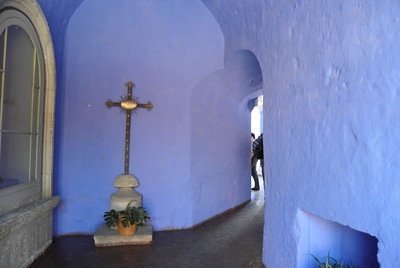
I did my round along Arequipa´s churches and convent on an early Sunday morning. It was mother´s day as well, so most of the churches were open for services and generally packed. People walked in and out, so it was not difficult for me to get in as well.
La Compania was my first stop, and this one already has the sculptured façade that Arequipa is known for. The rest of the construction is quite bland and bulky, which makes the decorations at the front really stand out. This church also has a façade at the side, with a fine sculpture of a knight (St. James) and two mermaids. At San Francisco church I first clearly saw the enormous vaults that support so many of the buildings here in Arequipa – to survive another earthquake that will come sooner or later. Via the small La Merced and the 18th century San Agustin, I arrived at the Santo Domingo church where the wooden altar stands out.
The convent of Santa Catalina is the highlight of the city and could have earned WH status on its own merits alone. A tour will take you along the different parts of the convent, which walls are painted red, blue and yellow to soften the reflection of the sun on the naturally white silla. This colouring I think is one of the reasons tourists enjoy it so much, it is very picturesque. But the convent's history is fascinating too: the nuns here were …
Keep reading 0 comments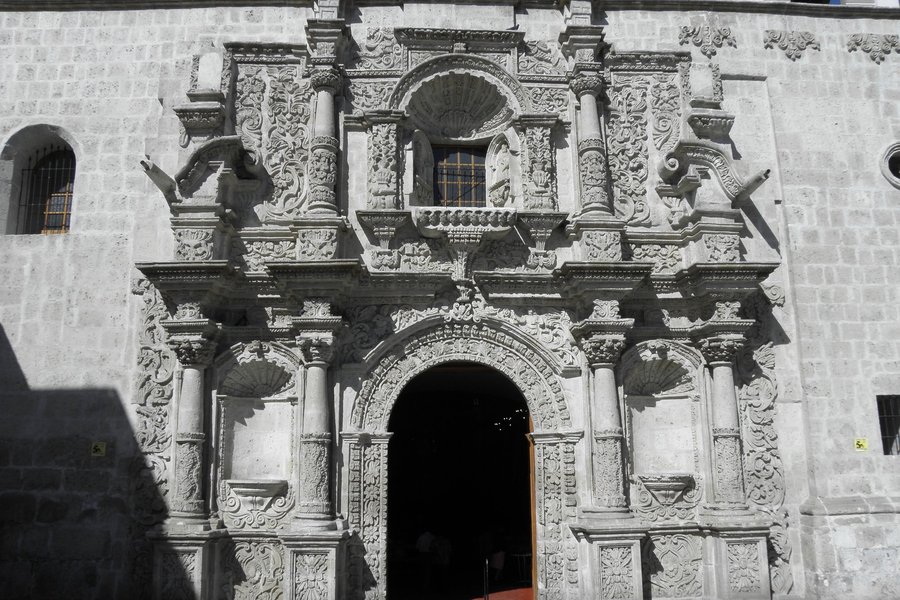
A beautiful colonial city and an ideal place to spend a day acclimatizing to altitude. Don't miss either the main square or the Santa Catalina Convent both of which are stunning.
As an aside I dinned in an Argentinian restraunt here - enjoying steak, salad and 'chips of the day,' which were made from three different sorts of potato one yellow, one bight orange and one pinky mauve!
Keep reading 0 comments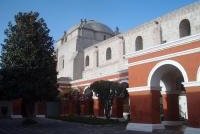
Ah, beautiful Arequipa, the colonial city surrounded by snowy volcanoes. The city has some beautiful churches and buildings with very ornate facades, there’s a nice vibe on the Plaza de Armas but the highlight of the city is the Santa Catalina Convent. Built from the white local Sillar stone, and often painted red or blue, this convent is an oasis in the busy city. It’s pretty much a small city within the city with it’s little charming streets, houses with ovens, squares with religious paintings and staircases.
The entrance fee is quite steep (you can easily buy two meals for it) but it’s definitely a place not to be missed.
Keep reading 0 comments
If you are journeying between Lima and the Altiplano at least 1 way by land (as you really should) then a stop over in Arequipa is certainly worthwhile both to break the journey and to take in this pleasant colonial town.
Its main claim to fame lies in the buildings, particularly the churches with their carved facades, built in the local white volcanic stone (photo).
Its climate is very fine with mostly clear sunny days, not too hot and providing wonderful views of the surrounding volcanoes – one of which “El Misti” is the archetypal volcanic conical shape. The Santa Catalina Convent is also worth a visit. (visited 1984)
Keep reading 0 comments
